Zero Waste Vegan Fridge and Freezer
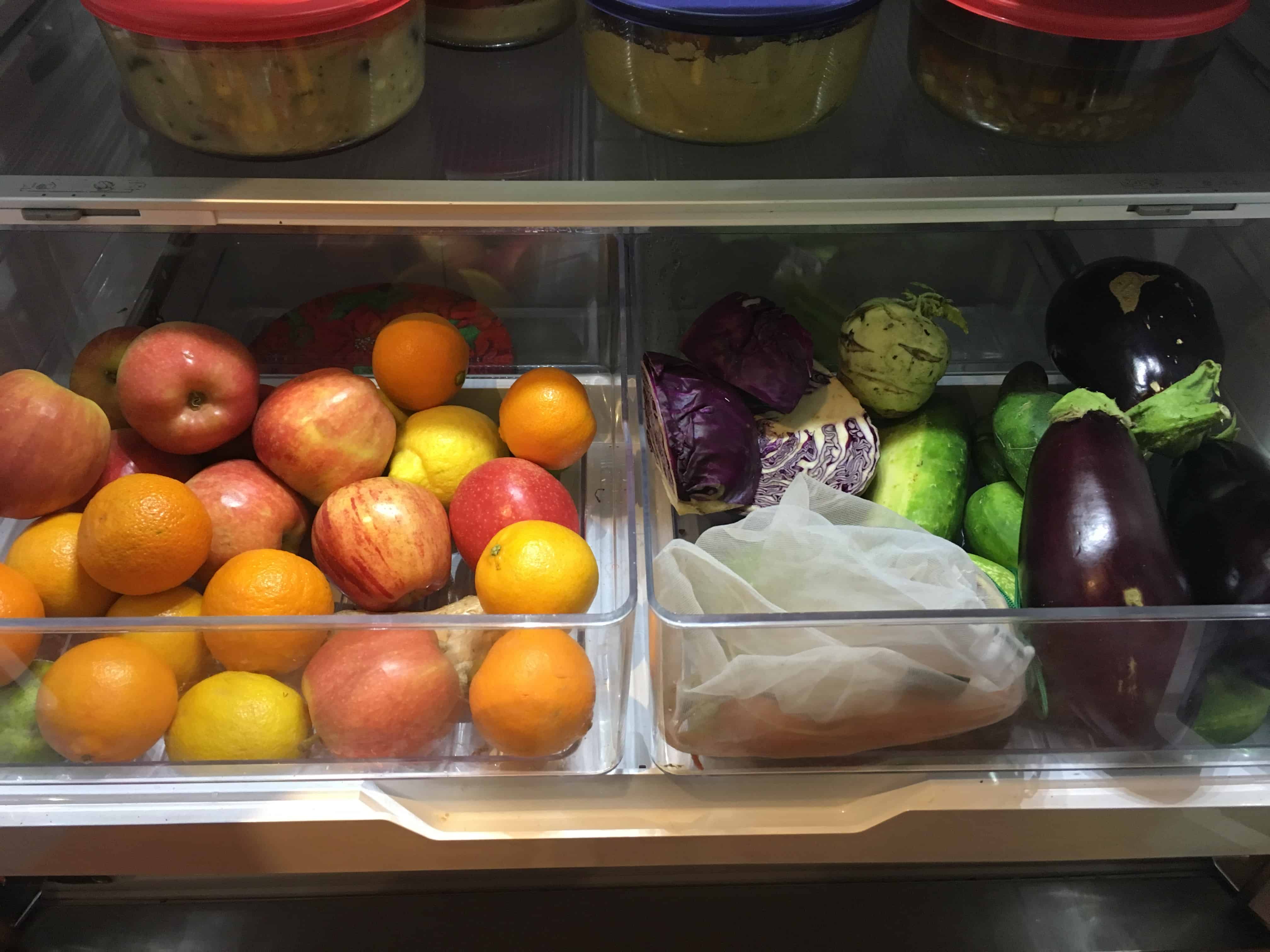
#VeganMoFo18 Day 4 – Zero Waste Vegan Fridge and Freezer
I think the most intimidating part of moving to a plastic-free, zero waste kitchen is in dealing with refrigerator and freezer food storage. Most of us have grown up with a fridge full of plastic—I know we had Tupperware® in our refrigerator and freezer when I was growing up, so I knew no other alternative. We’ve been working to cut down on food waste for the past several years and one way we’ve been successful at that was with Debbie Meyer® Green Bags—they’re great at keeping produce fresh, but they’re plastic! I really was at a loss at how to store fruits and vegetables without plastic bags, so it required some study. I knew it had to be possible, I mean, how did my grandparents store stuff in the fridge before plastics became so cheap and plentiful?
This winter I participated in the Tilth Alliance Soil and Water Stewardship program here in King County, Washington, and through that program I gained a lot of knowledge about zero waste, plastics, food waste, and food storage alternatives. During this program I received a fantastic handout from King County: Fruit and Vegetable Storage Guide: Keep it Fresh! This guide has been very helpful in outlining the best way to store food. A lot of produce can be simply stored loose in your crisper drawer, in a paper bag, wrapped in a damp tea towel, or in a sealed container. It does reference plastic bags from time to time, however, so I also use a reference from the Ecology Center who runs the Berkley, California Farmers’ Market for additional guidance on storing produce without plastic. Instead of listing it all over again, I’ll just have you download those two great documents.

Refrigerator shelves. Zucchini are wrapped in dry flour sack towels.
In our house, anything that has to be stored in a sealed container is stored in glass or metal. My go-to containers are, you guessed it, mason jars, but I also use Pyrex® Simply Store® lidded, glass containers. Like I mentioned in Zero Waste Pantry Part 2, I do use some containers with plastic lids, but I never fill them to the point where the food makes contact with the plastic. There are some older pyrex dishes with glass lids out there that I want to acquire—I just have to keep hunting thrift and antique stores for them because my mom would notice their absence if I stole them out of her cupboards!! But the plastic lids are nice if I am taking the container somewhere, like taking my breakfast or lunch to have at a presentation or class.
I’ve also been collecting metal cookie tins for food storage. They are great for storing tortillas I make, and work well in both the fridge and freezer. I do put down a layer of wax paper on the bottom and top of the stack of tortillas because, for some reason, the tortillas turn dark when they come into contact with the metal container. I freeze them this way as well. I also freeze other prepared foods in these this way, such as breaded eggplant, veggie burgers, cookies, etc.
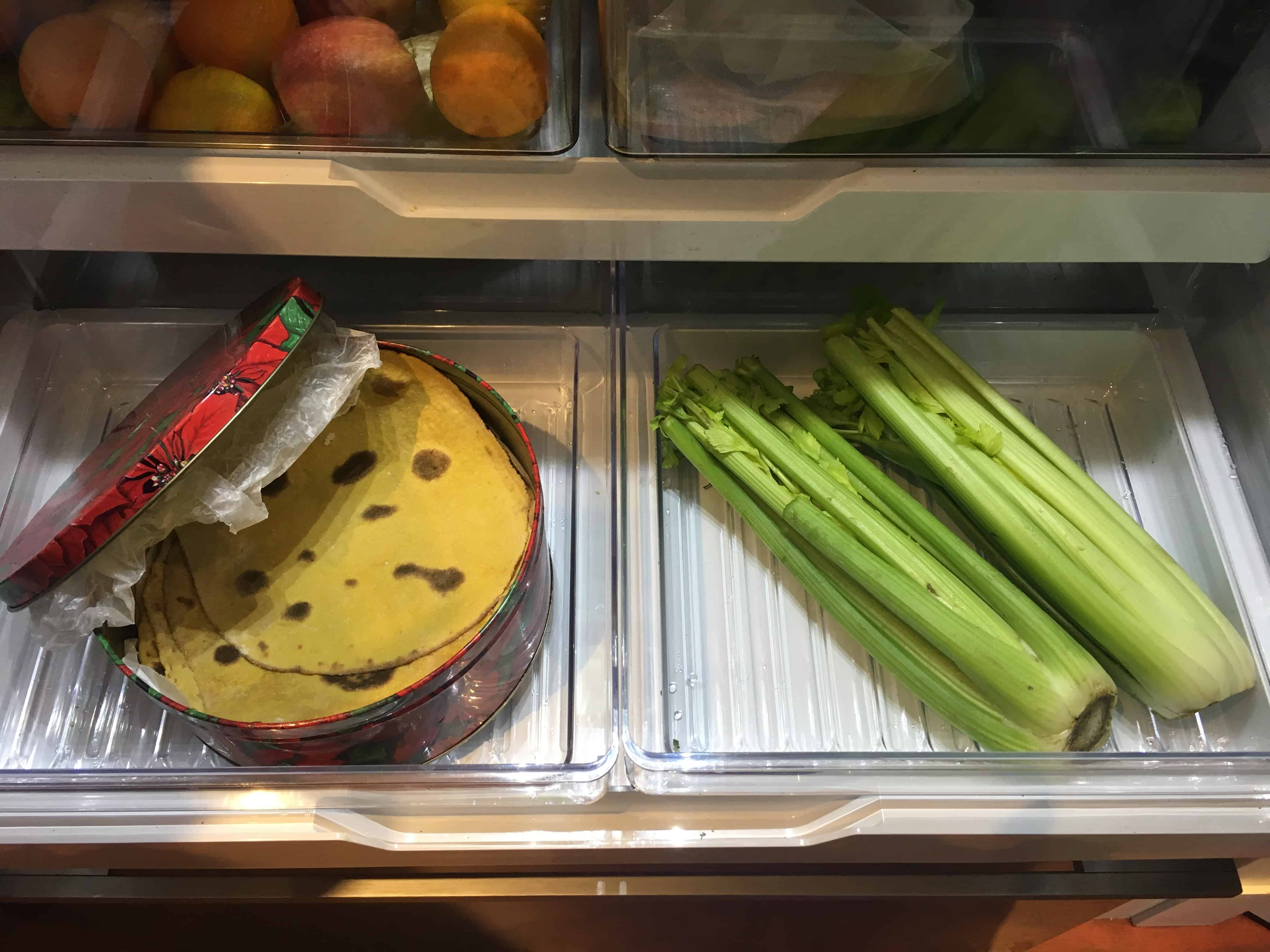
Homemade tortillas in metal tin. Loosely stored organic celery.
I also reuse glass containers to store condiments in the refrigerator. I make my own vegan Worcestershire sauce, balsamic glaze, chive vinegar, mustard, hot sauce, ketchup, etc. and reuse old glass jars for them. There is a plastic bottle of Sriracha sauce in there…it’s on my list to learn how to make when I run out!
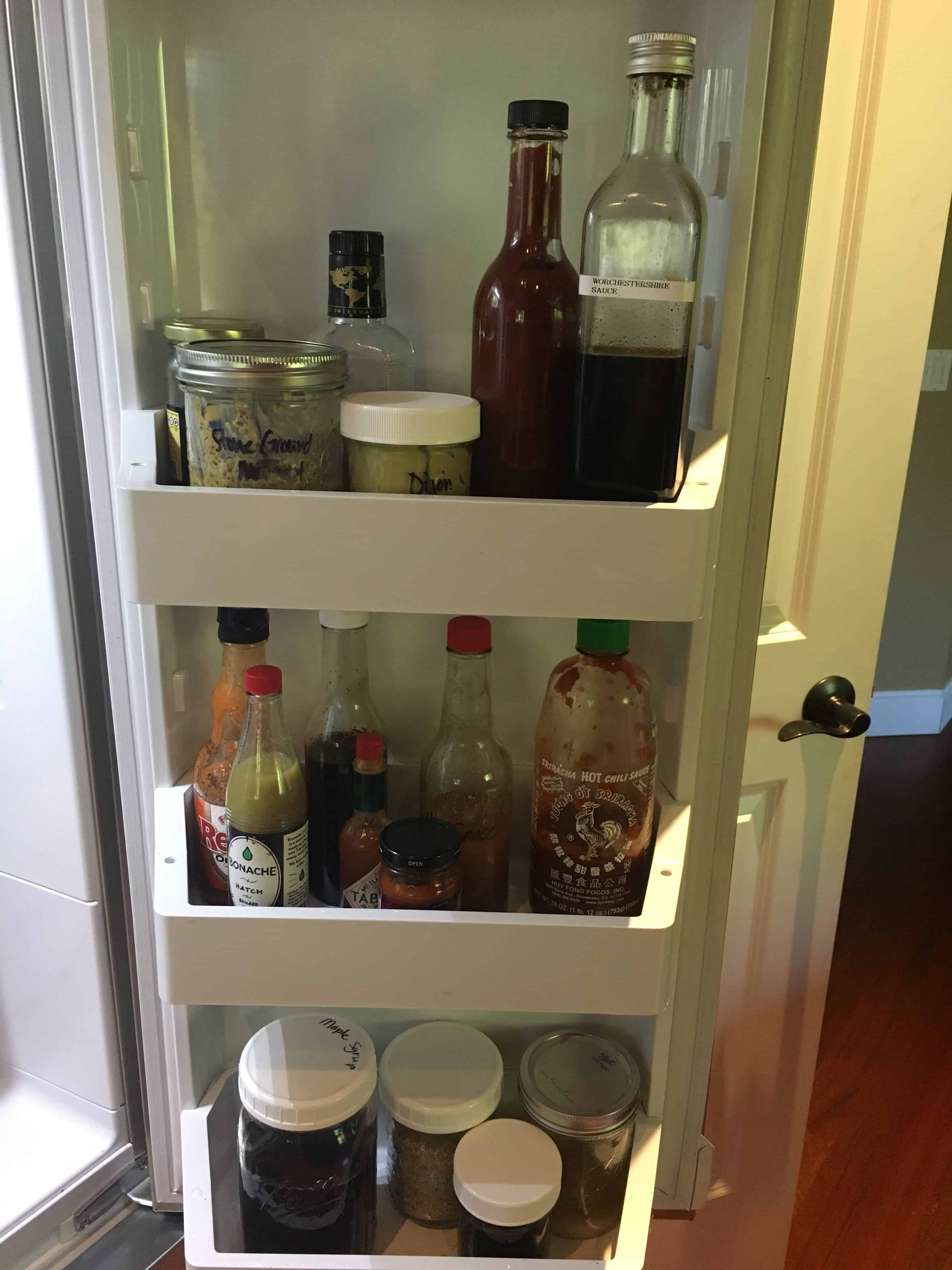
Vegan Condiments in Glass (except Sriracha)
Coming up in the blog will be posts on making mustard, hot sauce, ketchup, etc., so you will have resources to make your own, if you desire! I do have posts on making vegan yogurt and vegan kimchi, both of which are stored in mason jars in my fridge at most times.
So far it is working well. I do have to stay on top of the fruits and veggies and not let them wither away or spoil. It’s definitely one way to make sure we eat our produce! I try not to buy more than we’ll be able to eat. But if I do, I can turn them into soups or freeze them.
Something that we’ve found extremely helpful is to list what is available to eat in the fridge. I generally always know what’s in there, but Alan often does not. We both love leftovers and will eat them happily, but Alan often just doesn’t realize what’s in there, even if containers are labeled. And some times Alan eats things I’ve prepped for other meals, leaving me in a lurch at the last minute if he’s eaten it all up! So we keep a magnetic note pad on the front of the fridge listing what’s in there to eat. I can star them if there are things that need to be eaten first—Alan’s really good at checking the list and eating things up! I just have to remember to label everything in the fridge so he knows what is what. Another way to do this is to put an Eat Me First sign or box in your fridge and put items in it that need to be eaten right away.

To Eat List
Like many households, we do have a second refrigerator in our garage. Its mostly for overflow and when we have parties. We used to have bottles and bottles of beer in there, but we’ve switched to growlers and get fresh beer from our local brewery. Since football season is coming up, we’ll probably get a few more growlers so we have beer for our family when they come over to watch the games.
This fridge is also for extra produce. We store our potatoes in this fridge and right now its full of the bumper crop of pickling cukes and a ton of onions a local food bank couldn’t use and gave away (I’ll be dehydrating these onions this week).

Overflow veggie storage in garage fridge
Vegan Zero Waste Freezer
We use our freezers a lot. We have the freezers on our refrigerators and a deep freeze. The freezer on our inside fridge is used for things we use often, like bread (we buy Ezekiel bread now, but I’m working on coming up with a homemade version so we lose the plastic bag), squeezed lemon rinds for making infused water, berries for overnight oats and infused water, etc.

Shelves of cooked beans, banana chunks, jam, fruit in deep freezer
The deep-freeze is the powerhouse! I freeze a lot of produce to use during the winter. Being in the Pacific Northwest, we don’t have garden-fresh produce available in our home garden or even farmers markets year-round, so using frozen produce is the next best thing. I’d always kept bags and bags of frozen fruit and veggies in the deep freeze, but I needed to figure out a better way. So, again, the mason jar came to the rescue! Mason jars freeze beautifully, even with liquids (more on this in a moment). Freezing produce is extremely easy and if you do a bit of prep, you can also easily get them out of the jars as well! I’ll have a tutorial on freezing produce at the end of this post.
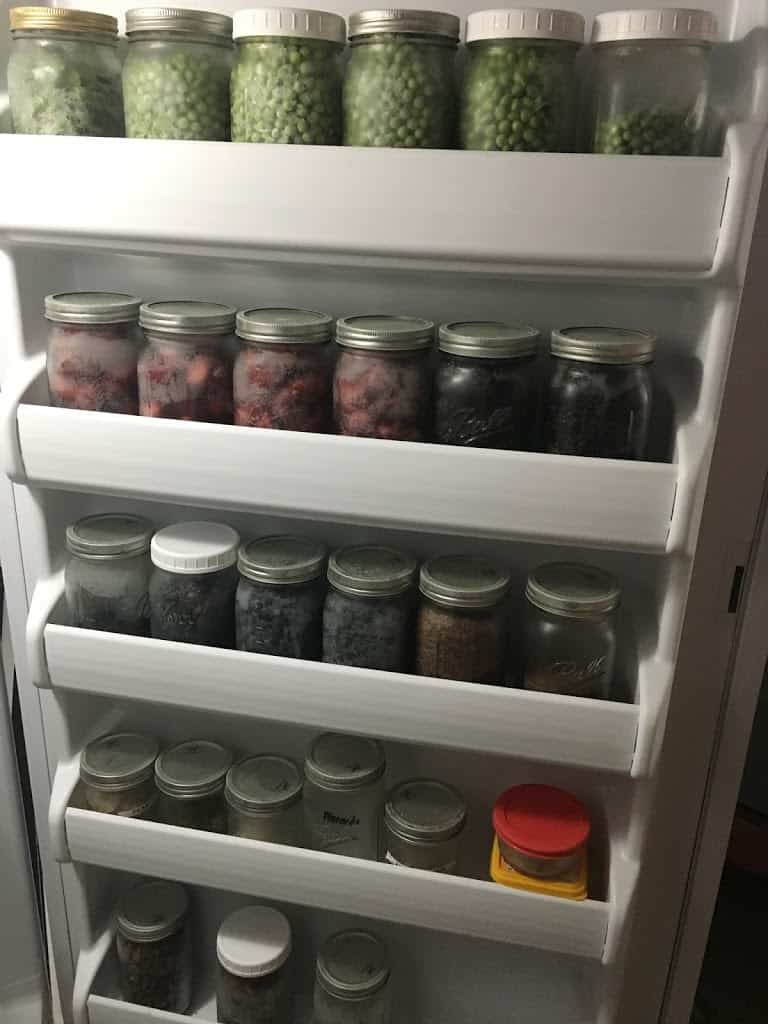
Frozen Veggies and Fruits in my Freezer
In addition to produce, we freeze nuts, dates, bread crumbs, cooked beans, cooked rice and grains, leftovers, veggie scraps, and vegetable broth. Having cooked beans and cooked grains make mealtime a snap as all I have to do is either thaw the containers in the refrigerator or pop them from frozen in the microwave (minus the lids) for use. I used to store veggie scraps in plastic bags, but they are great in quart mason jars, I simply pour warm water in the frozen scrap jar to release them and pour into a stock pot to make stock later. When I make veggie stock and want to freeze it, I pour the stock into jars but take care not to go above the round shoulder of the jar toward the neck, so the jar doesn’t break when the liquid expands. I also prefer to use metal lids and bands in the freezer as the plastic lids are really hard to loosen when frozen.
I usually have a big pan of something frozen in my deep freeze for our local homeless shelter. They have a Food Angel program where people can sign up to have frozen meals available at all times so the shelter can call up at a moment’s notice to pick up to serve a hot meal on nights they don’t have an organization providing one. I do use disposable aluminum trays for this as the shelter does not want to have to keep track of people’s bakeware. These trays are at least recyclable. We do cook some meals for the shelter and make enough on those nights to have extra to freeze for later.

More frozen veggies and meal tray for homeless shelter
I am working through the last few ziplock bags in the freezers. I have a couple of soups and several bags of frozen roasted pumpkin. Some of the pumpkin turned into pumpkin butter this week and the rest will become pumpkin tortillas. I refuse to throw the food out and will just store new stuff differently from now on. The used plastic bags will go to the plastic bag recycle bin when empty and clean.
Freezing Produce
Freezing produce is actually really simple. Fruit is the easiest, as you can freeze without blanching, while veggies require that extra step. Freezing works for berries, bananas (cut into chunks), kiwis, peaches, mango, green beans, peas, summer squash, okra, etc. You can freeze anything you can buy in the frozen section at the grocery store.
Fruit
Fruit Step 1. Prepare Fruit
For berries, simply remove hulls for strawberries. Don’t wash berries prior to freezing. For other fruits, peel and cut fruit.
Fruit Step 2. Arrange on Tray
For all fruit, put a silicone mat on baking tray. Arrange fruit on the mat so pieces don’t touch.

Tray of peaches ready for the freezer
Fruit Step 3. Freeze
Put in freezer, uncovered, until solidly frozen. I generally do overnight.
Fruit Step 4. Remove Frozen Fruit Pieces and Put into Mason Jar
The frozen fruit peels right off the silicon sheet. Work quickly so the fruit doesn’t thaw out. This way the pieces stay individual and don’t freeze into a clump that you can’t get out of the jar later.
Fruit Step 5. Put Mason Jar Lid on and Freeze.
Vegetables
Veggies Step 1. Prepare Veggies
Shell, peel, cut veggies. They are more successful if they are cut into sizes you will be using.

Shelled peas
Veggies Step 2. Blanch
You’ll need to blanch the vegetables so they retain color, flavor, and vitamins with the freezing process. Blanching simply means dunking in boiling water for a short time and then plunging them immediately in ice water to stop cooking (shocking). After icing them, put the vegetables in kitchen towels to remove excess water. Blanching times vary (peas only take 90 seconds while green beans and okra take 3 minutes), so refer to this chart from the National Center for Home Food Preservation to find times for the vegetables you are going to freeze.
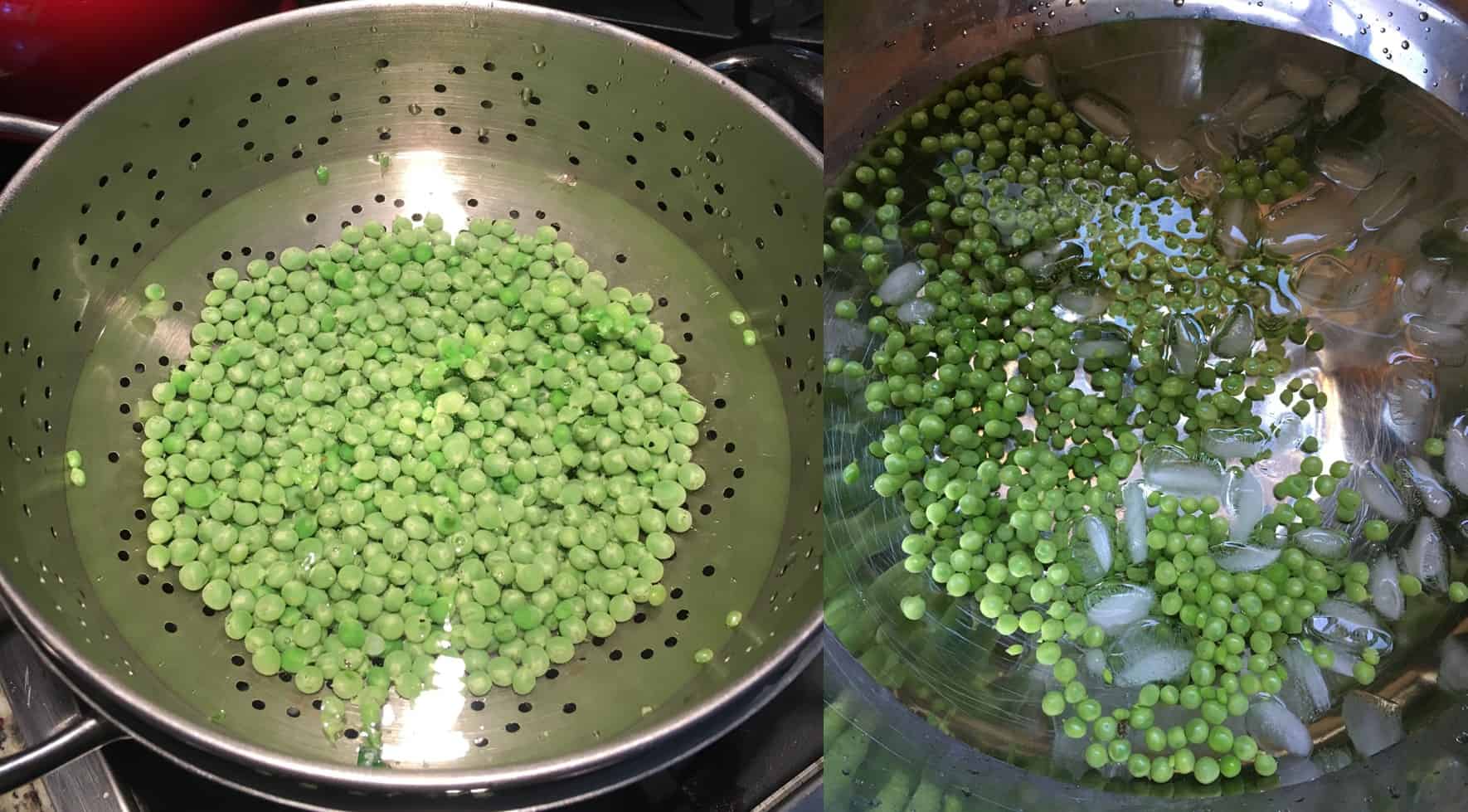
Left: Peas being blanched in boiling water. Right: Peas being shocked in ice water.
Veggies Step 3 Arrange on a Towel-covered Tray
I’ve found it much easier to remove frozen vegetables from cloth than the silicon sheet. Simply spread the cooled, blanched veggies over a dry towel on a baking sheet with space in between.
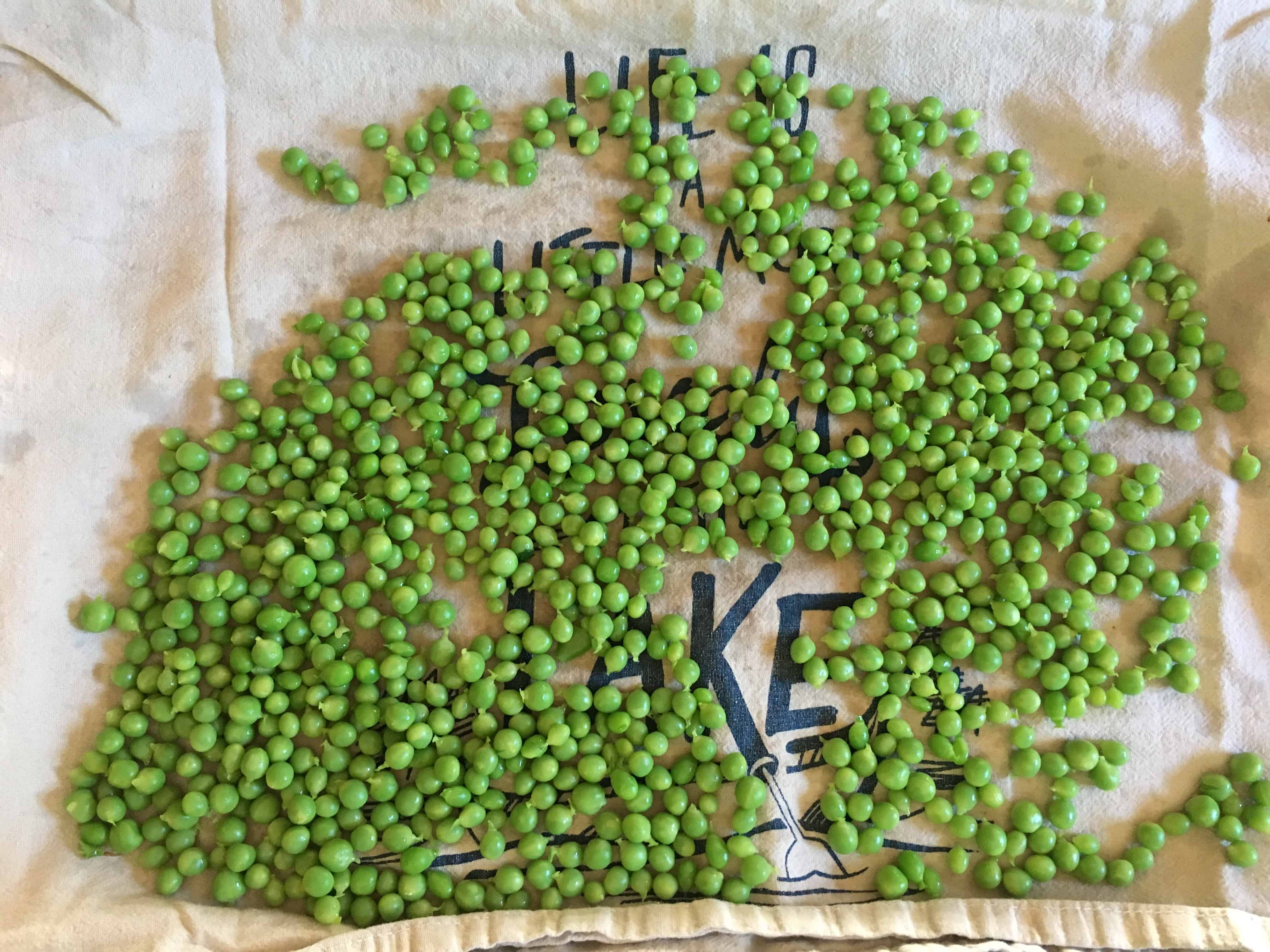
Blanched peas on towel ready for the freezer
Veggies Step 4. Freeze
Put in freezer, uncovered, until solidly frozen. I generally do overnight.
Veggies Step 5. Remove Frozen Veggie Pieces and Put into Mason Jar
The frozen veggies come right off the towel. I simply roll up the towel to pour the pieces right into a mason jar. Work quickly so the pieces don’t thaw out. This way the pieces stay individual and don’t freeze into a clump that you can’t get out of the jar later.
Veggies Step 6. Put Mason Jar Lid on and Freeze.
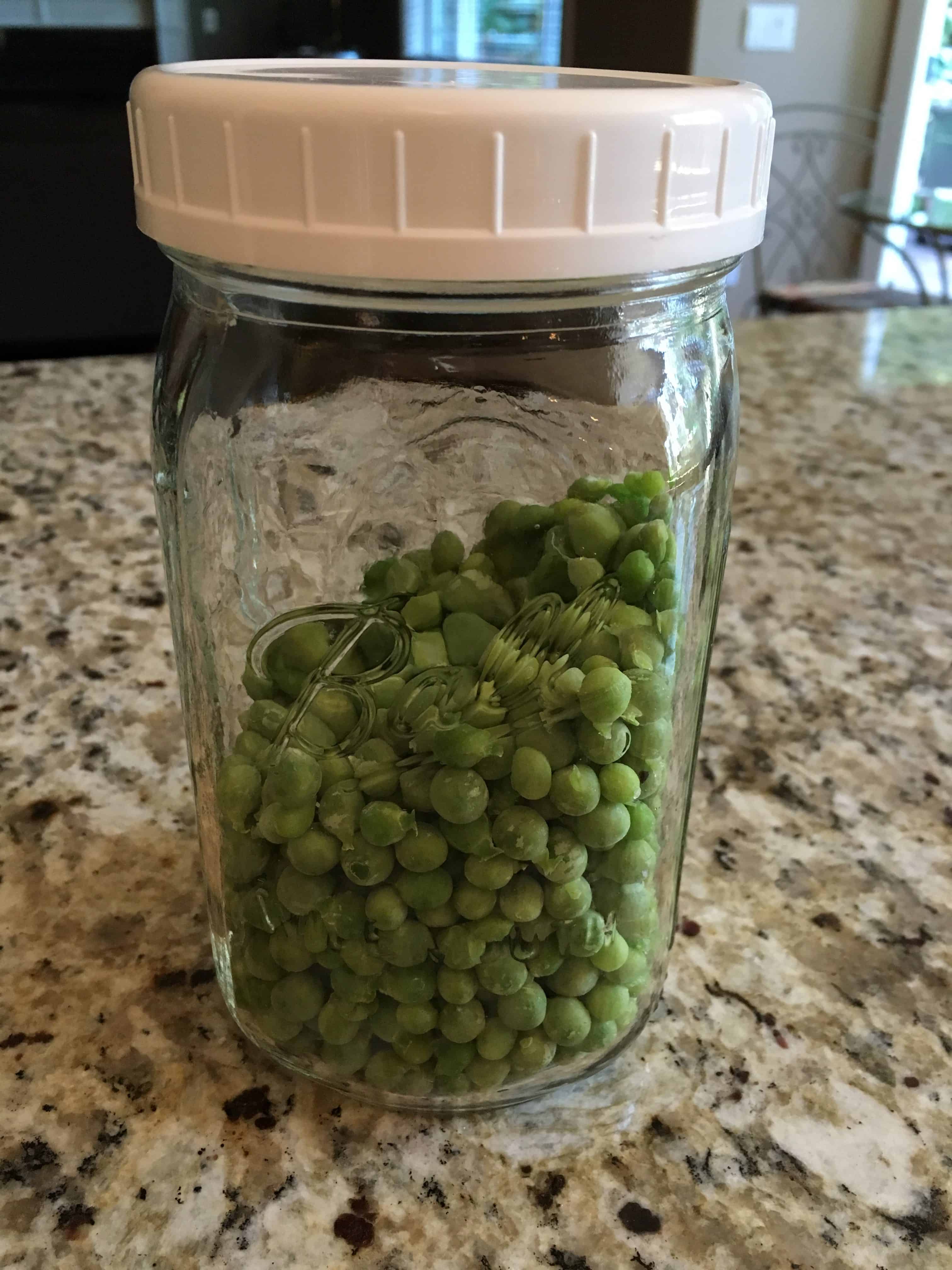
Jar of individually frozen peas.
It seems really daunting to go plastic-free in the refrigerator and freezer, but really, it’s not that bad at all. Its just a change in mindset, habit, and, in many cases, less packaging! Like the pantry transition, going plastic-free gave me much more storage room in our freezer. It used to be that I had stacks and stacks of plastic bags of frozen veggies, fruit, veggie scraps, soup, and when we opened the freezer door, it all came sliding out onto our feet. There’s only so much you can stack of frozen plastic bags before they go slip-sliding away! Now I have neatly arranged jars and the quart jars fit perfectly in the freezer door shelves. An added bonus—I can thaw the jars without food leaking all over my refrigerator as plastic bags inevitably got punctured in the freezer and leaked when thawed.
At this point, I’ve not found any stores that sell frozen fruit or veggies in bulk, so I have to prep this myself to avoid plastic bags. Our local QFC does sell frozen seafood and meat-based meal starters in bulk, something they just recently started, but they have yet to just have veggies or fruit available this way. I’ve not inquired whether they plan on moving in that direction or not—I should. All in all, it’s not that difficult…it’s as easy as boiling water!
I hope this was helpful. The next few posts will get more into food rather than simply storage. I’m excited to share some more zero waste options for vegans!
Do you like this post? Please share....
4 Comments
Leave a Comment
If you liked this post, you might like one of these:
Tags:

[Trī-māz-ing]
Cindy wants you to be Trimazing—three times better than amazing! After improving her health and fitness through plant-based nutrition, losing 60 pounds and becoming an adult-onset athlete, she retired from her 20-year firefighting career to help people just like you. She works with people and organizations so they can reach their health and wellness goals.
Cindy Thompson is a national board-certified Health and Wellness Coach, Lifestyle Medicine Coach, Master Vegan Lifestyle Coach and Educator, Fitness Nutrition Specialist, Behavior Change Specialist, and Fit2Thrive Firefighter Peer Fitness Trainer. She is a Food for Life Instructor with the Physicians Committee for Responsible Medicine, Rouxbe Plant-Based Professional, and Harvard Medical School Culinary Coach, teaching people how to prepare delicious, satisfying, and health-promoting meals.
She provides health and lifestyle coaching at Trimazing! Health & Lifestyle Coaching. Cindy can be reached at info@trimazing.com.
Subscribe to the Trimazing Blog
Receive occasional blog posts in your email inbox.
Subscribe to the Trimazing Blog
Receive occasional blog posts in your email inbox.





















This post is super helpful! I'll never be as organised and well-stocked as you, but there are lots of useful tips. I also love the sound of that Food Angel programme – what an amazing idea!
So many good tips here. I am definitely using the freezer more that ever but thing I can be even more clever with it. The food shelter idea is brilliant and good on you for participating. I try to support our local food for the homeless project by selling vegan baked goods at the music events my husband puts on and donating the money raised.
Thank you, I'm so glad it's helpful! The Food Angel program is so cool. They simply go down the list and see who has something available and come out to the house to get it! I'm happy to give a little space in my freezer to people who need a hot meal.
That's wonderful! Our shelter recently had a bake sale and I wanted to provide vegan treats for them to sell, but we were out of town when I heard about it. I should have some goodies in the freezer available for that next time!